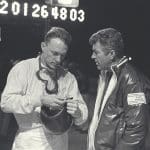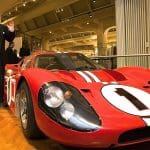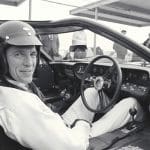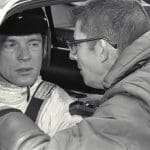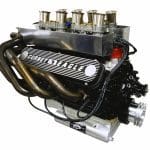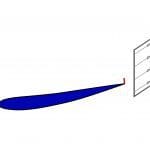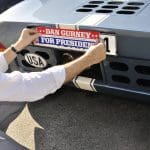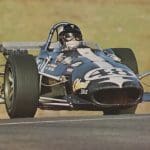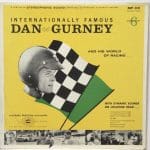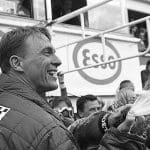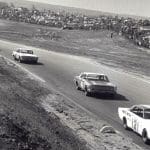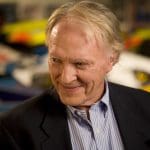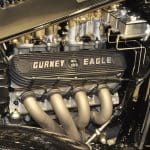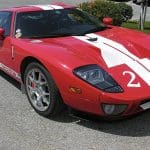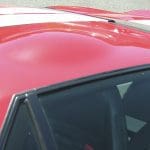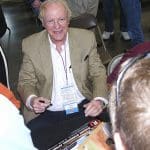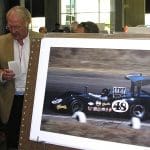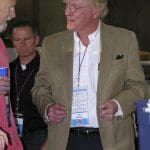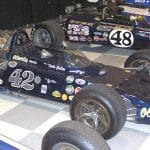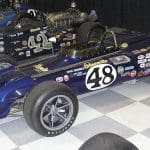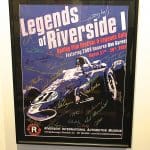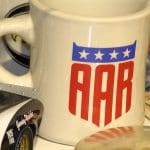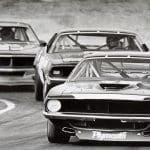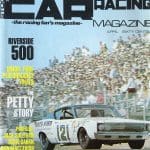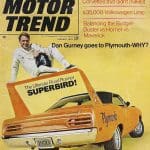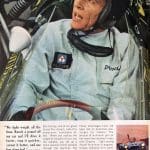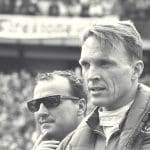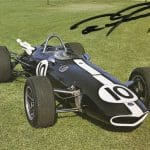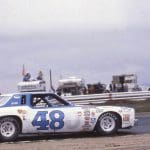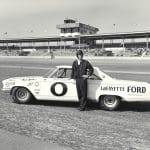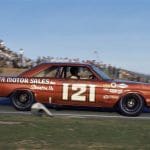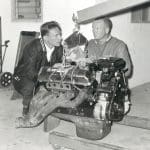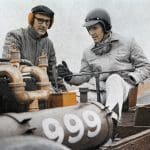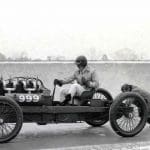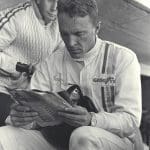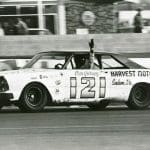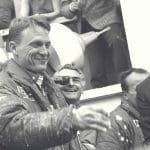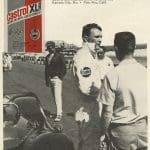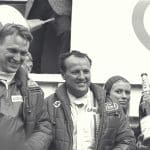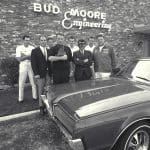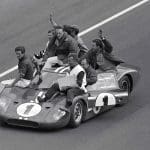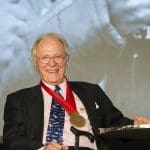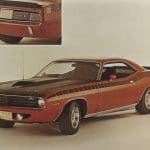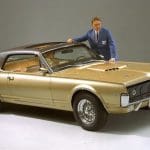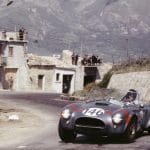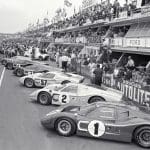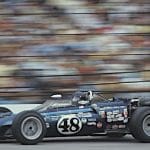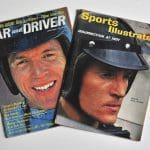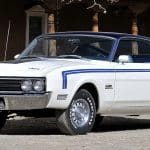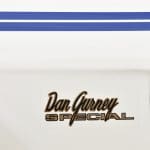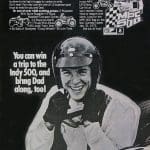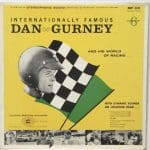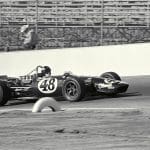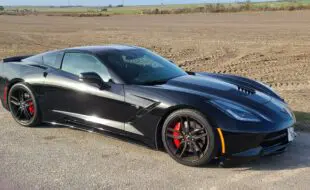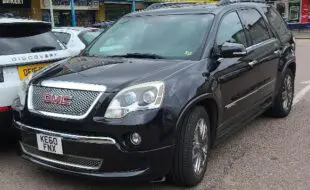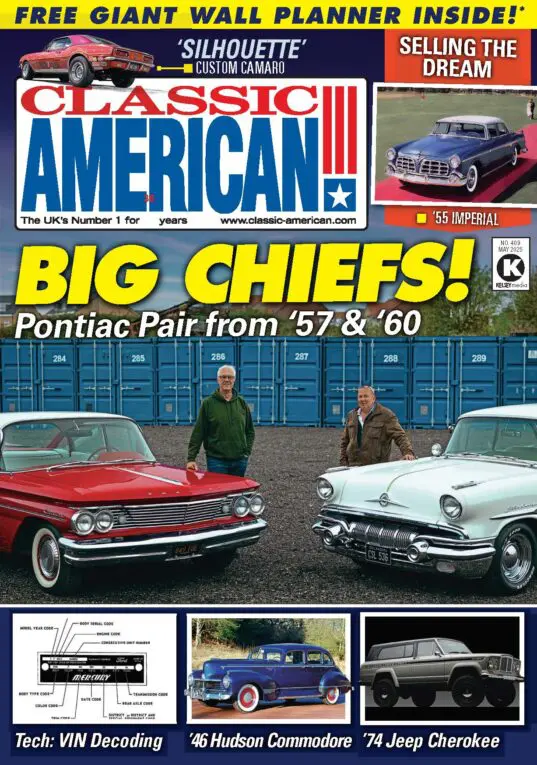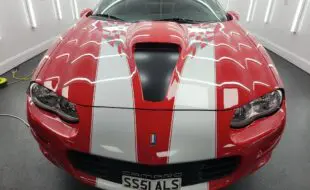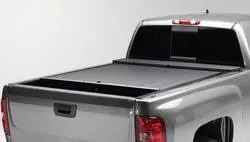Jim Maxwell salutes one of the most versatile racecar drivers in the history of auto racing: The legendary, multi-talented Dan Gurney who passed away recently…
Images: Ford Motor Company & Author’s collection
Enjoy more Classic American reading in the monthly magazine.
Click here to subscribe & save.
Daniel Sexton Gurney − legendary racer, successful racecar manufacturer and championship team owner, Gurney was the first to win races as a driver in the four major categories of motorsports: Grand Prix, Indy Car, Sports Car and NASCAR. All totalled, he raced in 303 events in 25 different makes of cars and won 48 different races, and finished on the podium an additional 41 times. At an early age he became infatuated with engines, reading about cars and ordering the ‘California Bill’s’ Hot Rod book which was advertised in car magazines. His grandfather, Frederick W. Gurney, invented the radial-thrust angular-contact bearing in 1902, so an interest in things mechanical had long been running in his family lineage.
After the Gurney family moved to Riverside, California in 1948, 17-year-old Dan was in a great place; Southern California being a hot rod and motorcycle heaven. His early vehicles included a chop-top ’32 Ford five-window coupe. In 1950 he drove his buddy Skip Hudson’s ’29 Ford Roadster to a 130.43 mph run at the Bonneville Salt Flats. He also ran at the dry lakes and the local drag strip in Santa Ana and was involved in his share of illegal street drag races: “I can recall getting out of bed one night and putting on a jacket over my pyjamas to race a hot-dog from another town.”
When he returned home from Army service in Korea in 1954, he got serious about automobile road racing. In 1955, he was racing in amateur events at places like Torrey Pines (San Diego), even though at that stage he had no idea how to do ‘heel and toe’ maneouvres with the pedals. Running around at high speeds at night on the dirt roads of Riverside he did, however, practice and learn the quick ways around corners.
In 1957 there was an opportunity to drive Calvin Bailey’s Corvette at the new Riverside racetrack and he did well, winning two class trophies. His talent behind the wheel of that Corvette really put Gurney into the limelight in the LA sports car world. Also in 1957, he got a big break in his career when he caught the attention of a wealthy car owner named Frank Arciero who had a powerful, hard-to-drive and fast 4.91-litre Ferrari that Dan knew how to drive, winning at Paramount Ranch in December 1957. In 1958 he drove a Ferrari at Le Mans and Enzo Ferrari hired him to be a factory driver later that year, and in the three races he ran, he got a 2nd, 3rd and 4th place. By 1961, he was tied for third place in the world championship.
Enter Shelby
Around this timeframe, a racer named Carroll Shelby beat Gurney at a race at Riverside (Dan had mechanical difficulties at the end of the race); however, it was soon after that Dan came back and defeated Shelby at a Palm Springs’ race. A trip to Silverstone in England saw Gurney race in a British Saloon race in 1961, driving his 409cu in equipped bubble-top Impala. He took the pole with the powerful American sedan and was dominating until the engine let go. “I knew that American cars could compete with the European sedans at that time,” recalls Gurney. “The ’61 Impala looked like a rocket ship compared to the boxy Jaguars that had been dominating the Saloon racing.”
Gurney drove a Buick-powered rear-engined car belonging to Mickey Thompson in the 1962 running of the Indy 500 with a 20th place finish. In late 1964 he went into business with Carroll Shelby (Shelby opted out in 1970), with the start-up of “All American Racers”, a shop devoted to the construction of racecars. AAR would be the home of the famous ‘Eagle’ line of racing cars, featuring a monocoque chassis design and was known for their rugged construction, their impeccable handling (when properly set up for each race course), and their clean attractive body contours. The opening in the front for cooling air intake was styled to have the look of an eagle’s beak.
By 1967 Dan was still a highly sought after racecar driver and Ford Motor Company wanted him behind the wheel of their GT40 at Le Mans. Driving a big, heavy and thirsty Ford GT40 Mk IV that was equipped with a 427cu in engine, the duo of Californian Dan Gurney and Texan AJ Foyt, (a three-time Indy 500 winner,) won it all!
Gurney took the lead after the first hour and the car was in first place, the balance of the 24-hour event. With less than four hours to go, Gurney had been leading by more than 32 miles, with the final driving duties turned over to AJ for his last shift. At the chequered flag, it was an all-American win. The durable Mk IV Ford from Dearborn had traveled 3267 miles at an average speed of 135.49mph, both new records. In the wake of all the fun, Dan Gurney became the first man in motor racing history to ‘fizz the bottle’ and spray its contents to the surrounding crowd on the victory podium. All the photographers and people surrounding the podium got a shower of champagne, and that started a new tradition in racing which is still being used to this day. In the 1968 running of the Indy 500, Gurney’s Eagle racecars finished 1, 2, and 4. The winning car was Bobby Unser, Dan in 2nd, and Denis Hulme in 4th. That remarkable finishing order was a huge feat to achieve, and it all happened as a direct result of Gurney’s burning desire to be the best there could be.
Engine-building Excellence
During this era in the power department Gurney was a pioneer too. Working along with England’s Harry Weslake, they developed a new cast aluminum cylinder head for the Fairlane Ford V8 engine, featuring funnel-sized ports along with oversized 2.03-inch intake valves and 1.62-inch exhaust valves. The 1968 rules for Indy Car racing allowed ‘stock block’ engines to run approximately 50 more cubic inches than the overhead-cam engines and that was the reason for Gurney to look to running this special powerplant.
The AAR shop in Santa Ana was state-of-the-art all the way and featured a complete machine shop, dyno room, ‘clean’ room which was hospital- clean (dust and temperature-controlled) for assembling race engines. On the Formula 1 side, Gurney built a 3.0-litre,12-cylinder ‘Gurney-Weslake’ race engine, and the special re-worked small-block V8 Ford engine for Indy Cars.
After being involved with racing Cougars in the Trans-Am series for Mercury, Gurney signed a contract in late 1969 to run a team for Plymouth − a pair of Barracudas, one for Dan and the other for his protégé, Swede Savage. His time with Mercury was frustrating as he felt all along that Ford didn’t want the Cougars to win, as the primary focus was on the Mustangs. The Cougars, with his help, came within two points of winning the Trans-Am Manufacturer’s Championship at the end of 1967.
The new Mopars were expertly prepared at the AAR facility (over 75,000 man hours were put into them by a crew of 50 men,) along with extra sponsorship by Mattel Hot Wheels and Castrol. Power came from Keith Black-built 305cu in small blocks which were in actual fact de-stroked 340s. Although placing first eluded the Gurney/Savage team, the cars − always high and in the money − showed flashes of brilliance.
“Our Barracudas weighed 300 pounds more at the end of the season than they did at the beginning because of the factory mandates,” recalled Gurney in 2001. “Our cars were built like an anvil, but they were slow and uncompetitive.” Chrysler dropped their Trans-Am program and didn’t participate in the series for 1971. Dan retired as a driver at the end of 1970. Highly respected as an ace behind the wheel, he felt it was time to move on, to concentrate in being a team owner and helping other drivers. “I don’t want to go on driving forever,” he told a magazine reporter at the time. He began talking about getting new drivers. “It seems right that I pass my knowledge along.”
The Later Years
In later years (from 1983 to 1999) he ran a successful race team with Toyota and Goodyear as the major backers, then he developed a special low-rider motorcycle using Honda single-piston power. Back to four wheels, his AAR facility played a key role in the development and construction of a new and revolutionary ‘Delta Wing’ car that had a true “clean sheet of paper” design concept, featuring a very unique narrow front with wide-rear stance. In 2015 Dan Gurney’s AAR was involved in the building of a new GT-R LM Nismo race car for Le Mans, a potential contender for the World Endurance Championship.
And today, at age 85, he’s got a new ‘moment-cancelling’ engine design recently patented, a vertical twin with counter rotating crankshafts designed for smoothness. He recalls: “after modifying and trying to improve Ford V8 flat heads, Ford 289 rocker arm engines, push rod 427 Fords, Chevy small blocks and big blocks of all sizes, Coventry Climax 4 bangers, Indy Ford four-cammers, turbo Offy Indy engines, turbo Cosworth Indy engines, Triumph, BSA, Harley, Kawasaki, Suzuki, Yamaha, Honda, Montesa for motorcycles, S & S V-twins for motorcycles.
“Also along the way were some Gurney Weslake cylinder heads for small block Fords and our own three-valve per cylinder V8 Ford conversion. Indy and NASCAR 355 cu in engines, (middle of the front row at Indy 500 in 1981) and quite a few others, 3.0-litre V-12 F1 engine plus experience with Ferrari, BRM, Porsche, Brabham, Lotus, and more, it finally dawned on me that AAR could design and build a whole engine from scratch if we had the desire.” His new powerplant could be enlarged to 4 or 8 cylinders. The Dan Gurney story is so lengthy there’s no way to cover everything in one single article. However, it has to be said that for enthusiasts of American iron, he will long be remembered for his exploits with Detroit-based V8-powered race cars.
*****Box-out*******
Gurney and Riverside International Raceway
It has been said that it’s rare when one driver becomes inextricably linked to a single track; that a driver’s performance at one course is so consistently outstanding that you can’t think of one without the other. In the case of Dan Gurney and Southern California’s Riverside International Raceway, Gurney proved his driving talents over and over again at this iconic road-race course. The 2.6-mile, nine-turn track was built in 1957 and Dan Gurney was there at the beginning, actually even before the beginning! “There were rumours that Riverside was going to be built,” remembers Dan Gurney in a 2002 interview. “I used to go out there on my motorcycle and follow the bulldozers around as they were flattening what would become the circuit. As it actually started to turn into reality, well, it was a dream come true. Here it was in my hometown and I had visions of sugarplums and I felt so lucky, like this was going to be a steppingstone to be able to become a professional racecar driver. I ended up getting some of my biggest breaks for my own personal career at Riverside.”
In addition to winning with sports cars, Gurney won Riverside in 1963 in a Holman and Moody Galaxie, and then drove for the Wood Bros. the following years. Here’s how car owner Glenn Wood recalls the way Gurney performed while winning with his cars from 1964 through 1966: “It’s hard to match the experience of a driver like Dan Gurney on a road course, particularly his home track so close to where he was brought up. When he drove our cars out there, he’d pull into victory lane and the car would look as if it was brand new. It’d look like we hadn’t had it out of the garage area. That’s the kind of road course driver he was.” Gurney blew a motor in 1967, but won again in 1968. The race was at one time colloquially known as “The Dan Gurney 500.”

